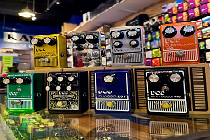We often get asked for individual strings (which we are perfectly happy to sell), and they are a useful thing to have in your bag or case for those times when one goes while on stage.
However, I always make a point to ask if the purchase is because the same string keeps breaking, even after little use. I'm often surprised at how 'normal' people find this, but it can be a symptom of a bigger problem, and solving that problem can save you money in the long run.
If you're consistently breaking the same string over and over, it's worth checking all the contact points of that string. More often than not, particularly on Les Paul style tune-o-matic bridges, the cause is a sharp edge on the saddle. A light filing to remove this will reduce breakages considerably. Sharp edges can appear on all types of saddle, so this is the first thing to check. Another factor with this style of bridge is the break angle over the saddle to the tail-piece. Regular breakages are often caused by this angle being too steep (i.e. the tune-o-matic bridge is set high, and the stop-tailpiece set very low, creating a steep angle that the string has to go over).
With acoustic guitars, the string that tends to go the most often is the G. This is because it is actually the thinnest string on an acoustic guitar. The core of the G is thinner than the B or E strings, but the winding (which adds no strength at all, only mass) makes it look bigger. To help lengthen the life of the G, I always recommend giving it 4 or 5 winds around the post, so that the bottom wind is below the post hole and the angled notch.
Most breakages will be through the natural wear-and-tear strings go through. If you're breaking more than your fair share, try these little tips. If you're breaking strings due to how hard you're hitting them (something I wouldn't discourage), then perhaps a heavier gauge is what you're after!
Until next time, TECH care of yourselves, and your guitars. Ed.










